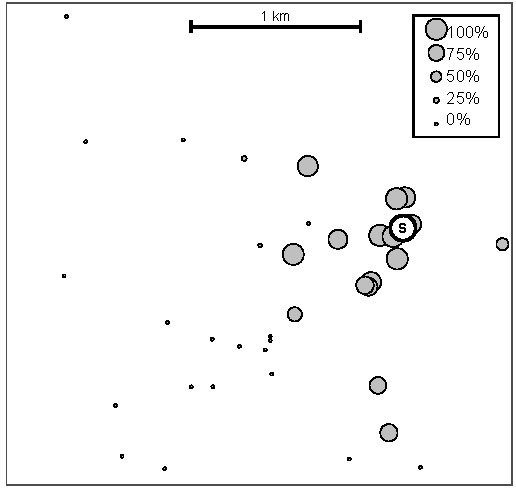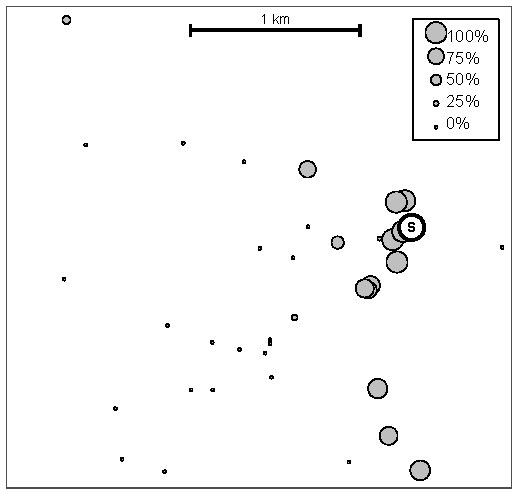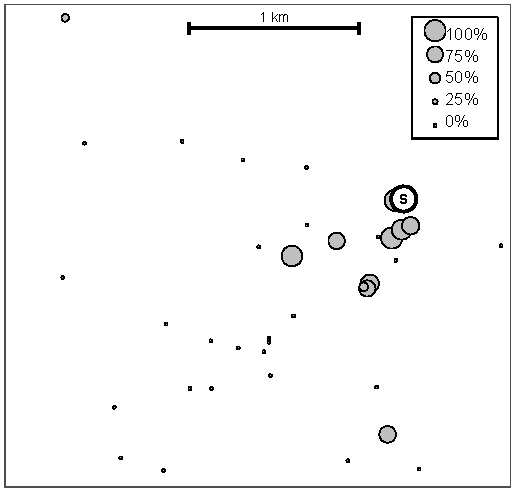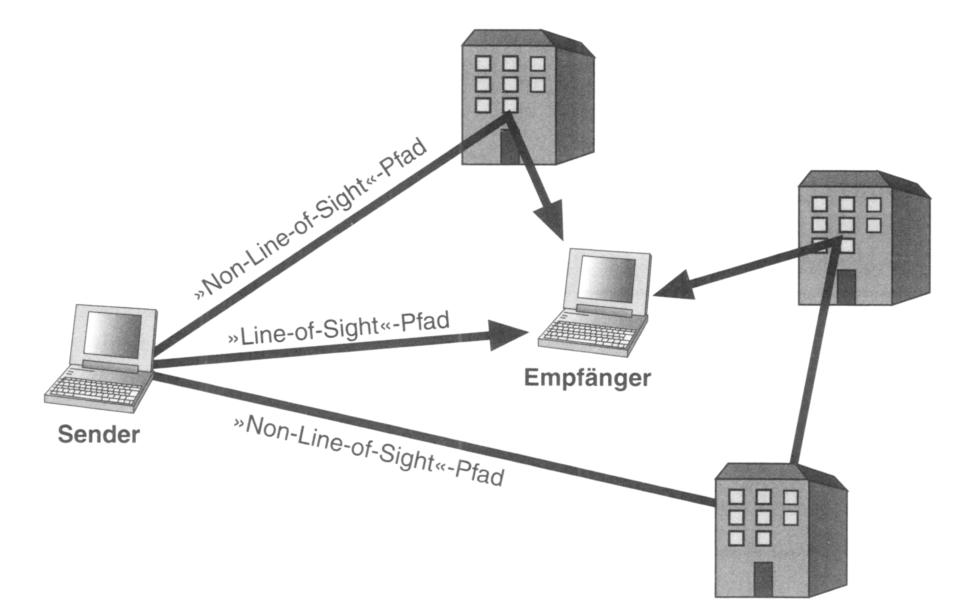Link-level Measurements from an 802.11b Mesh Network: Difference between revisions
No edit summary |
|||
| Line 1: | Line 1: | ||
=The Problem= |
|||
(This article is a stub. Details will be added soon.) |
|||
The general goal is to examine the properties of unplanned wireless networks. Most routing algorithms we know today were developed for the domain of wired networks. As wireless technology emerged for common use many of these algorithms were adopted. |
|||
== References == |
|||
The question investigated here is, whether it is advisable to use these algorithms. By taking a closer look at the phenomena appearing in the field of wireless networking, it is possible to gain a deeper understanding of the inherent characteristics and therefore the challenges that these networks pose. |
|||
Special interest is put on identifiing the properties that distinguish wireless networks from traditional wired ones. If this succeeds, researchers will be able to design new, better routing algorithms which address the problems and shortcomings of wireless networking and exploit the phenomena appearing in the field. |
|||
==Handling the problem== |
|||
To answer these questions a group of researchers carried out a case study based on an existing urban wireless network, the MIT RoofNet. |
|||
{|width="100%" border="0" |
|||
|- |
|||
|[[Image:Fig2.jpg|thumb|center|400px|A map showing the location of the RoofNet nodes.]] |
|||
|- |
|||
|} |
|||
RoofNet is an urban community network designed to provide a high speed internet access to its users, while keeping the organisational overhaed low. RoofNet has a unplanned mesh architecture in the sense that the position of the nodes is determined only by the fact, where its users happen to live. |
|||
The network spreads over an area of approximately six square kilometers and is located in Cambridge, Massechusetts. Each node in the network is basically a BSS consisting of a PC with an 802.11 card in it and a roof mounted omnidirectional antenna. |
|||
The internet access is provided by a few wired gateways, which advertise themselves as such to the rest of the network. The users are free to transform their BSS into a gateway by making their internet access available to the others. |
|||
Because RoofNet is above all a research project, the users agree that experiments will be carried out from time to time. The conclusions presented here are implications drawn from such experiments. |
|||
=Potential sources for packet loss in RoofNet= |
|||
Many of the existing routing algorithms rely on the assumption, that the neighbor abstraction holds. This is certainly true as far as wired networks are concerned. In the research community there is no consensus on whether or not it is also true for wireless networks. |
|||
If it were true, it would imply, that an arbitrary pair of nodes is either able to communicate with each other or not at all. We therefore could expect the loss rates to be either very low or very high depending on the concerned node pair. |
|||
Without claiming general validity for all kinds of wireless networks, the experiments show, that the neighbor abstraction does not hold for RoofNet. One of the experiments revealed a surprising pattern of loss rates for this particular network. Appearently in RoofNet intermediate loss rates are the common case. As the graphic below shows, the majority of the nodes, that can communicate, exhibit intermediate loss rates, designating the nodes with very high and very low loss rates to be the marginal cases. |
|||
{|width="100%" border="0" |
|||
|- |
|||
|[[Image:Fig4.jpg|thumb|center|400px|The distribution of delivery probabilities in RoofNet. The figure shows only the pairs of nodes, that managed to exchange at least one packet during the experiment.]] |
|||
|- |
|||
|} |
|||
The question arising from this result is how this particular pattern can be explained. While searching for the answers to this question the researchers investigated among others the following hypotheses as potential causes for this fact: |
|||
* The effects of node proximity |
|||
* The effects of signal-to-noise ratio |
|||
* The effects of transmit bitrate |
|||
* The effects of multi-path fading |
|||
In the following sections a brief summary of the results for each hypothesis will be given. |
|||
==Effects of node proximity on loss rates== |
|||
Trying to explain the loss rate pattern as a function of node distance at the first glance seems to be a very promising approach. But the data obtained from the experiments shows that node proximity is a very weak predictor for loss rates. The following three graphics strengthen the results. They show the delivery probabilities of three sender nodes to all other RoofNet nodes. The bigger the diameter of a circle is, the bigger is the delivery probability to the corresponding RoofNet node. |
|||
{|width="100%" border="0" |
|||
|- |
|||
|width="50%"|[[Image:Fig5-1.jpg|thumb|center|300px|]] |
|||
|width="50%"|[[Image:Fig5-2.jpg|thumb|center|300px|]] |
|||
|- |
|||
|width="50%" colspan="2"|[[Image:Fig5-3.jpg|thumb|center|300px|]] |
|||
|} |
|||
For inter node distance to be the explaination for the distribution of the loss rates, there should be a correlation between the distance and the resulting delivery probability. One could expect the recieved signal to be consistently weaker, the bigger the distance to the source node is. |
|||
The surprising fact is, that this is not the case. Inter node distance certainly determines the delivery probability to some extent, but the correlation is not consistent. As the graphics show, even very small variations of the sender position have tremendous effects on the resulting pattern of delivery probabilities. If node proximity was the decisive factor, we would certainly see a stronger correlation. |
|||
==The effect of signal-to-noise ratio== |
|||
The predominance of intermediate loss rates could be due to marginal signal-to-noise values for the majority of the nodes. The 802.11 cards used in RoofNet are based on the Prism Chipset. According to the Prism specification the range of signal-to-noise values, which result in a packet error rate between 10\% and 90\%, is 3db wide. |
|||
In order to blame the intermediate delivery probabilities on the signal-to-noise ratio, it should be possible to find most of the node pairs in RoofNet in this narrow range. |
|||
But again the experiments reveal, that reality looks different. As the following graphic shows, the range of signal-to-noise ratios is much wider than expected. |
|||
{|width="100%" border="0" |
|||
|- |
|||
|[[Image:Fig13.jpg|thumb|center|400px|Distribution of the average signal-to-noise values for the sender-reciever pairs.]] |
|||
|- |
|||
|} |
|||
The graphic implies, that signal-to-noise ratio is not a decisive factor for the distribution of loss rates. |
|||
==The effect of transmit bitrate== |
|||
As far as transmit bitrate is concerned, there are a couple of interesting implications, that can be drawn from the experiments. These experiments show, that the transmit bitrate that provides optimum performance in terms of throughput, is not characterized by the minimum loss rate. On the contrary, the optimum bitrate of 12 Mbps exhibits a significant loss rate. The results of a corresponding experiment are visualised in the following figures. |
|||
{|width="100%" border="0" |
|||
|- |
|||
|[[Image:Fig16.jpg|thumb|center|350px|The effect of transmit power on the delivery probability]] |
|||
||[[Image:Fig17.jpg|thumb|center|350px|The throughput in RoofNet at different bitrates. Data is ordered by the throughput at 11 Mbps.]] |
|||
|- |
|||
|} |
|||
These results suggest to change the policy of bitrate selection algorithms: Instead of reducing the bitrate immediately, when transmission errors occur, a bitrate selection algorithm for wireless networks should wait, because despite of the errors and the nessecary retransmissions a higher bitrate performs significantly better than a lower one at its optimum. |
|||
==The effect of multi-path fading== |
|||
The fact, that so many node pairs have intermediate delivery probabilities in RoofNet, is probably due to the phenomenon of multi-path fading. From all of the experiments, that were performed in this context, the one investigating the effect of multi-path fading led by far to the strongest results. |
|||
The challenge, that multi-path-fading poses to the manufacturers of 802.11 cards is illustrated in the following figure. |
|||
{|width="100%" border="0" |
|||
|- |
|||
|[[Image:Multipath.jpg|thumb|center|400px|A schematic visualization of multi-path fading.]] |
|||
|- |
|||
|} |
|||
The problem that arises here is the one of distinguishing between the actual signal and the interfering copies of it. The manufacturers of recievers handle this problem to some extent but the results are far from optimum. While the RAKE reciever used in RoofNet suppresses the copies for up to 250 nanoseconds, actual delay spreads for outdoor wireless networks reach an interval of one microsecond. The development of methods to tackle this problem is a subject of research. |
|||
Up to now it is impossible to measure the paths a signal follows, directly. This is the reason why the researchers used another experimental method to generate useful results. The methodology used in this case was to emulate signal paths. In detail, a model with two parameters was used: the delay between the line-of-sight signal and its copy and their relative strengths. |
|||
The following figure shows the effect of this approach on the loss rate (the bitrate used here is 11 Mbps). |
|||
{|width="100%" border="0" |
|||
|- |
|||
|[[Image:Fig19-4.jpg|thumb|center|900px|The result of an emulator experiment at 11 Mbps.]] |
|||
|- |
|||
|} |
|||
=References= |
|||
* [http://pdos.csail.mit.edu/~rtm/papers/p442-aguayo.pdf D. Aguayo, J. Bicket, S. Biswas, G. Judd, R. Morris: Link-level Measurements from an 802.11b Mesh Network] |
* [http://pdos.csail.mit.edu/~rtm/papers/p442-aguayo.pdf D. Aguayo, J. Bicket, S. Biswas, G. Judd, R. Morris: Link-level Measurements from an 802.11b Mesh Network] |
||
* Rech, Jörg: ''Wireless LANs. 802.11-WLAN-Technologie und praktische Umsetzung im Detail''. Heise; 2. aktualisierte und erweiterte Auflage (Juni 2006). ISBN 3936931291 |
* Rech, Jörg: ''Wireless LANs. 802.11-WLAN-Technologie und praktische Umsetzung im Detail''. Heise; 2. aktualisierte und erweiterte Auflage (Juni 2006). ISBN 3936931291 |
||
=External links= |
|||
* [http://pdos.csail.mit.edu/roofnet/doku.php MIT RoofNet] |
* [http://pdos.csail.mit.edu/roofnet/doku.php MIT RoofNet] |
||
Revision as of 17:35, 13 July 2007
The Problem
The general goal is to examine the properties of unplanned wireless networks. Most routing algorithms we know today were developed for the domain of wired networks. As wireless technology emerged for common use many of these algorithms were adopted.
The question investigated here is, whether it is advisable to use these algorithms. By taking a closer look at the phenomena appearing in the field of wireless networking, it is possible to gain a deeper understanding of the inherent characteristics and therefore the challenges that these networks pose.
Special interest is put on identifiing the properties that distinguish wireless networks from traditional wired ones. If this succeeds, researchers will be able to design new, better routing algorithms which address the problems and shortcomings of wireless networking and exploit the phenomena appearing in the field.
Handling the problem
To answer these questions a group of researchers carried out a case study based on an existing urban wireless network, the MIT RoofNet.
 |
RoofNet is an urban community network designed to provide a high speed internet access to its users, while keeping the organisational overhaed low. RoofNet has a unplanned mesh architecture in the sense that the position of the nodes is determined only by the fact, where its users happen to live.
The network spreads over an area of approximately six square kilometers and is located in Cambridge, Massechusetts. Each node in the network is basically a BSS consisting of a PC with an 802.11 card in it and a roof mounted omnidirectional antenna.
The internet access is provided by a few wired gateways, which advertise themselves as such to the rest of the network. The users are free to transform their BSS into a gateway by making their internet access available to the others.
Because RoofNet is above all a research project, the users agree that experiments will be carried out from time to time. The conclusions presented here are implications drawn from such experiments.
Potential sources for packet loss in RoofNet
Many of the existing routing algorithms rely on the assumption, that the neighbor abstraction holds. This is certainly true as far as wired networks are concerned. In the research community there is no consensus on whether or not it is also true for wireless networks.
If it were true, it would imply, that an arbitrary pair of nodes is either able to communicate with each other or not at all. We therefore could expect the loss rates to be either very low or very high depending on the concerned node pair.
Without claiming general validity for all kinds of wireless networks, the experiments show, that the neighbor abstraction does not hold for RoofNet. One of the experiments revealed a surprising pattern of loss rates for this particular network. Appearently in RoofNet intermediate loss rates are the common case. As the graphic below shows, the majority of the nodes, that can communicate, exhibit intermediate loss rates, designating the nodes with very high and very low loss rates to be the marginal cases.
 |
The question arising from this result is how this particular pattern can be explained. While searching for the answers to this question the researchers investigated among others the following hypotheses as potential causes for this fact:
- The effects of node proximity
- The effects of signal-to-noise ratio
- The effects of transmit bitrate
- The effects of multi-path fading
In the following sections a brief summary of the results for each hypothesis will be given.
Effects of node proximity on loss rates
Trying to explain the loss rate pattern as a function of node distance at the first glance seems to be a very promising approach. But the data obtained from the experiments shows that node proximity is a very weak predictor for loss rates. The following three graphics strengthen the results. They show the delivery probabilities of three sender nodes to all other RoofNet nodes. The bigger the diameter of a circle is, the bigger is the delivery probability to the corresponding RoofNet node.
 |
 |
 | |
For inter node distance to be the explaination for the distribution of the loss rates, there should be a correlation between the distance and the resulting delivery probability. One could expect the recieved signal to be consistently weaker, the bigger the distance to the source node is.
The surprising fact is, that this is not the case. Inter node distance certainly determines the delivery probability to some extent, but the correlation is not consistent. As the graphics show, even very small variations of the sender position have tremendous effects on the resulting pattern of delivery probabilities. If node proximity was the decisive factor, we would certainly see a stronger correlation.
The effect of signal-to-noise ratio
The predominance of intermediate loss rates could be due to marginal signal-to-noise values for the majority of the nodes. The 802.11 cards used in RoofNet are based on the Prism Chipset. According to the Prism specification the range of signal-to-noise values, which result in a packet error rate between 10\% and 90\%, is 3db wide.
In order to blame the intermediate delivery probabilities on the signal-to-noise ratio, it should be possible to find most of the node pairs in RoofNet in this narrow range.
But again the experiments reveal, that reality looks different. As the following graphic shows, the range of signal-to-noise ratios is much wider than expected.
 |
The graphic implies, that signal-to-noise ratio is not a decisive factor for the distribution of loss rates.
The effect of transmit bitrate
As far as transmit bitrate is concerned, there are a couple of interesting implications, that can be drawn from the experiments. These experiments show, that the transmit bitrate that provides optimum performance in terms of throughput, is not characterized by the minimum loss rate. On the contrary, the optimum bitrate of 12 Mbps exhibits a significant loss rate. The results of a corresponding experiment are visualised in the following figures.
 |
 |
These results suggest to change the policy of bitrate selection algorithms: Instead of reducing the bitrate immediately, when transmission errors occur, a bitrate selection algorithm for wireless networks should wait, because despite of the errors and the nessecary retransmissions a higher bitrate performs significantly better than a lower one at its optimum.
The effect of multi-path fading
The fact, that so many node pairs have intermediate delivery probabilities in RoofNet, is probably due to the phenomenon of multi-path fading. From all of the experiments, that were performed in this context, the one investigating the effect of multi-path fading led by far to the strongest results.
The challenge, that multi-path-fading poses to the manufacturers of 802.11 cards is illustrated in the following figure.
 |
The problem that arises here is the one of distinguishing between the actual signal and the interfering copies of it. The manufacturers of recievers handle this problem to some extent but the results are far from optimum. While the RAKE reciever used in RoofNet suppresses the copies for up to 250 nanoseconds, actual delay spreads for outdoor wireless networks reach an interval of one microsecond. The development of methods to tackle this problem is a subject of research.
Up to now it is impossible to measure the paths a signal follows, directly. This is the reason why the researchers used another experimental method to generate useful results. The methodology used in this case was to emulate signal paths. In detail, a model with two parameters was used: the delay between the line-of-sight signal and its copy and their relative strengths.
The following figure shows the effect of this approach on the loss rate (the bitrate used here is 11 Mbps).
 |
References
- D. Aguayo, J. Bicket, S. Biswas, G. Judd, R. Morris: Link-level Measurements from an 802.11b Mesh Network
- Rech, Jörg: Wireless LANs. 802.11-WLAN-Technologie und praktische Umsetzung im Detail. Heise; 2. aktualisierte und erweiterte Auflage (Juni 2006). ISBN 3936931291